Construction Technology Report: Commercial Building Analysis
VerifiedAdded on 2021/06/01
|20
|6521
|356
Report
AI Summary
This report, prepared for Al Hussein Technical University's School of Construction Technology and Built Environment, offers a comprehensive overview of construction technology with a focus on commercial buildings. It begins by defining key terminology used in construction, differentiating between residential, commercial, and industrial building types, and outlining functional characteristics and design selection criteria specific to commercial projects. The report then explores site preparation, including pre-design studies and soil investigations, and delves into structural design, covering substructures, superstructures, and various structural frames. Sustainability is emphasized throughout, with discussions on material selection, waste management, and the importance of green building practices. The report concludes by summarizing the key aspects of construction technology relevant to commercial buildings, providing valuable insights for architectural engineering students.
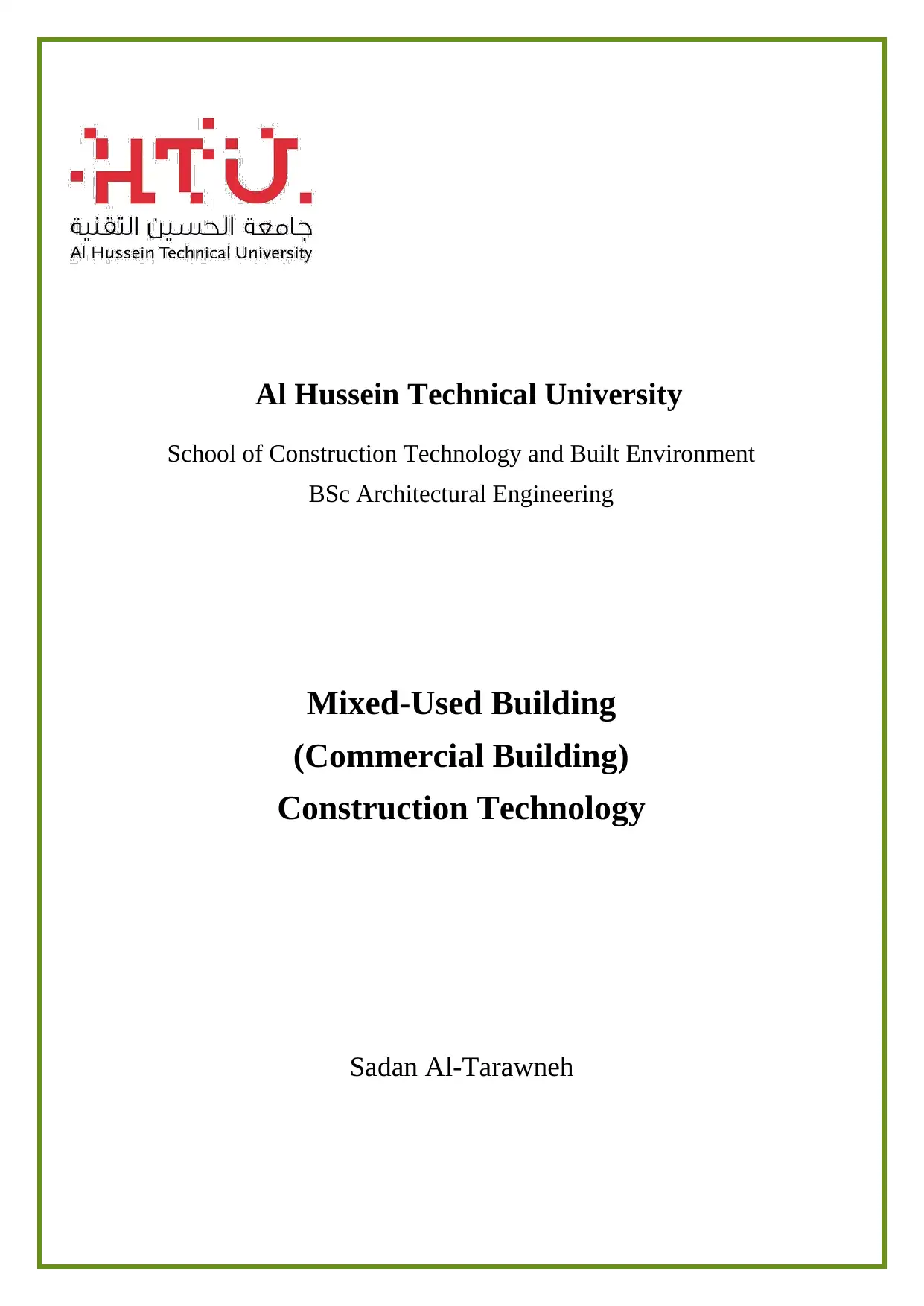
Al Hussein Technical University
School of Construction Technology and Built Environment
BSc Architectural Engineering
Mixed-Used Building
(Commercial Building)
Construction Technology
Sadan Al-Tarawneh
School of Construction Technology and Built Environment
BSc Architectural Engineering
Mixed-Used Building
(Commercial Building)
Construction Technology
Sadan Al-Tarawneh
Paraphrase This Document
Need a fresh take? Get an instant paraphrase of this document with our AI Paraphraser
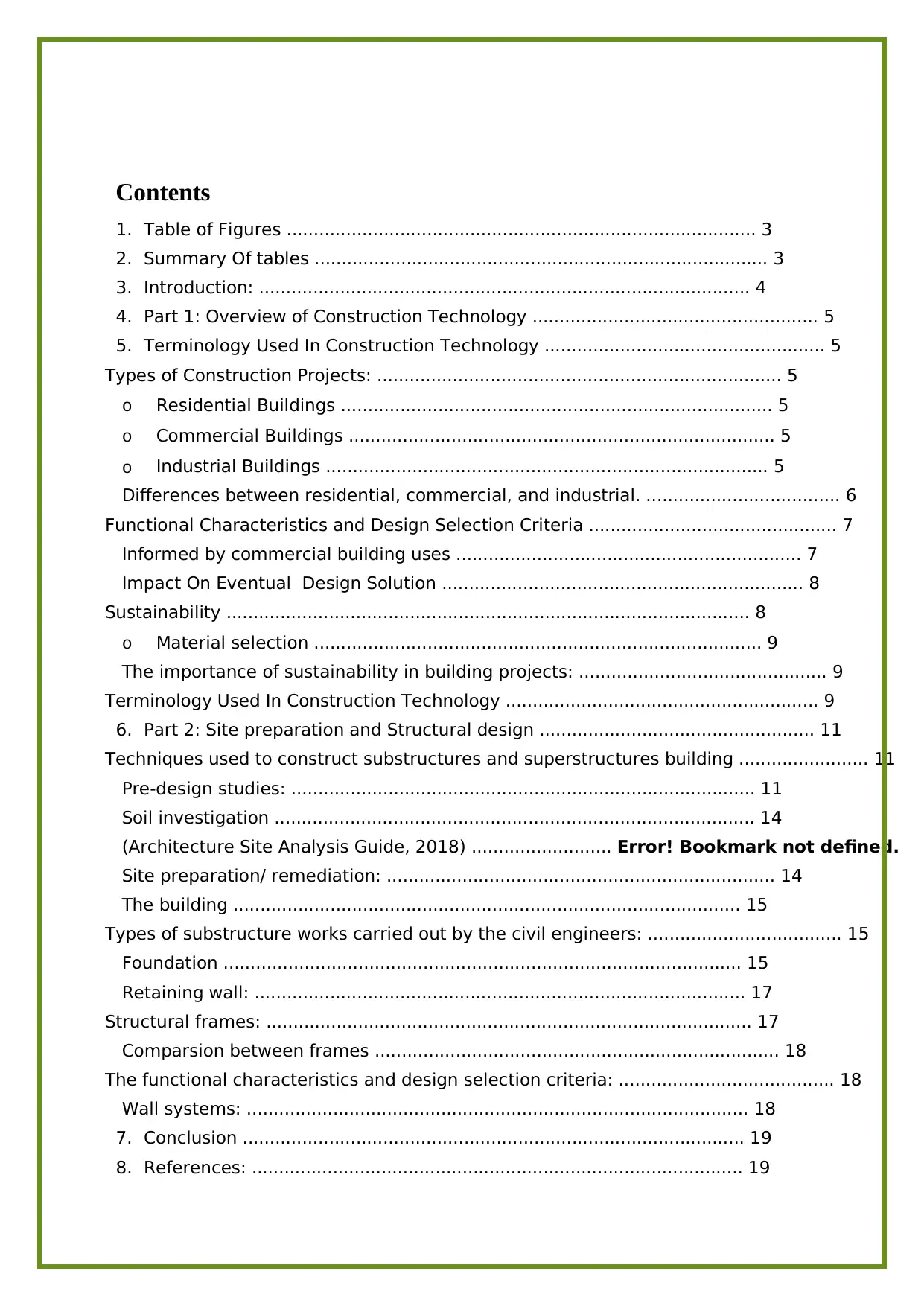
Contents
1. Table of Figures ....................................................................................... 3
2. Summary Of tables .................................................................................... 3
3. Introduction: ........................................................................................... 4
4. Part 1: Overview of Construction Technology ..................................................... 5
5. Terminology Used In Construction Technology .................................................... 5
Types of Construction Projects: ........................................................................... 5
o Residential Buildings ................................................................................ 5
o Commercial Buildings ............................................................................... 5
o Industrial Buildings .................................................................................. 5
Differences between residential, commercial, and industrial. .................................... 6
Functional Characteristics and Design Selection Criteria .............................................. 7
Informed by commercial building uses ................................................................ 7
Impact On Eventual Design Solution ................................................................... 8
Sustainability ................................................................................................. 8
o Material selection ................................................................................... 9
The importance of sustainability in building projects: .............................................. 9
Terminology Used In Construction Technology .......................................................... 9
6. Part 2: Site preparation and Structural design ................................................... 11
Techniques used to construct substructures and superstructures building ........................ 11
Pre-design studies: ...................................................................................... 11
Soil investigation ......................................................................................... 14
(Architecture Site Analysis Guide, 2018) .......................... Error! Bookmark not defined.
Site preparation/ remediation: ........................................................................ 14
The building .............................................................................................. 15
Types of substructure works carried out by the civil engineers: .................................... 15
Foundation ................................................................................................ 15
Retaining wall: ........................................................................................... 17
Structural frames: .......................................................................................... 17
Comparsion between frames ........................................................................... 18
The functional characteristics and design selection criteria: ........................................ 18
Wall systems: ............................................................................................. 18
7. Conclusion ............................................................................................. 19
8. References: ........................................................................................... 19
1. Table of Figures ....................................................................................... 3
2. Summary Of tables .................................................................................... 3
3. Introduction: ........................................................................................... 4
4. Part 1: Overview of Construction Technology ..................................................... 5
5. Terminology Used In Construction Technology .................................................... 5
Types of Construction Projects: ........................................................................... 5
o Residential Buildings ................................................................................ 5
o Commercial Buildings ............................................................................... 5
o Industrial Buildings .................................................................................. 5
Differences between residential, commercial, and industrial. .................................... 6
Functional Characteristics and Design Selection Criteria .............................................. 7
Informed by commercial building uses ................................................................ 7
Impact On Eventual Design Solution ................................................................... 8
Sustainability ................................................................................................. 8
o Material selection ................................................................................... 9
The importance of sustainability in building projects: .............................................. 9
Terminology Used In Construction Technology .......................................................... 9
6. Part 2: Site preparation and Structural design ................................................... 11
Techniques used to construct substructures and superstructures building ........................ 11
Pre-design studies: ...................................................................................... 11
Soil investigation ......................................................................................... 14
(Architecture Site Analysis Guide, 2018) .......................... Error! Bookmark not defined.
Site preparation/ remediation: ........................................................................ 14
The building .............................................................................................. 15
Types of substructure works carried out by the civil engineers: .................................... 15
Foundation ................................................................................................ 15
Retaining wall: ........................................................................................... 17
Structural frames: .......................................................................................... 17
Comparsion between frames ........................................................................... 18
The functional characteristics and design selection criteria: ........................................ 18
Wall systems: ............................................................................................. 18
7. Conclusion ............................................................................................. 19
8. References: ........................................................................................... 19
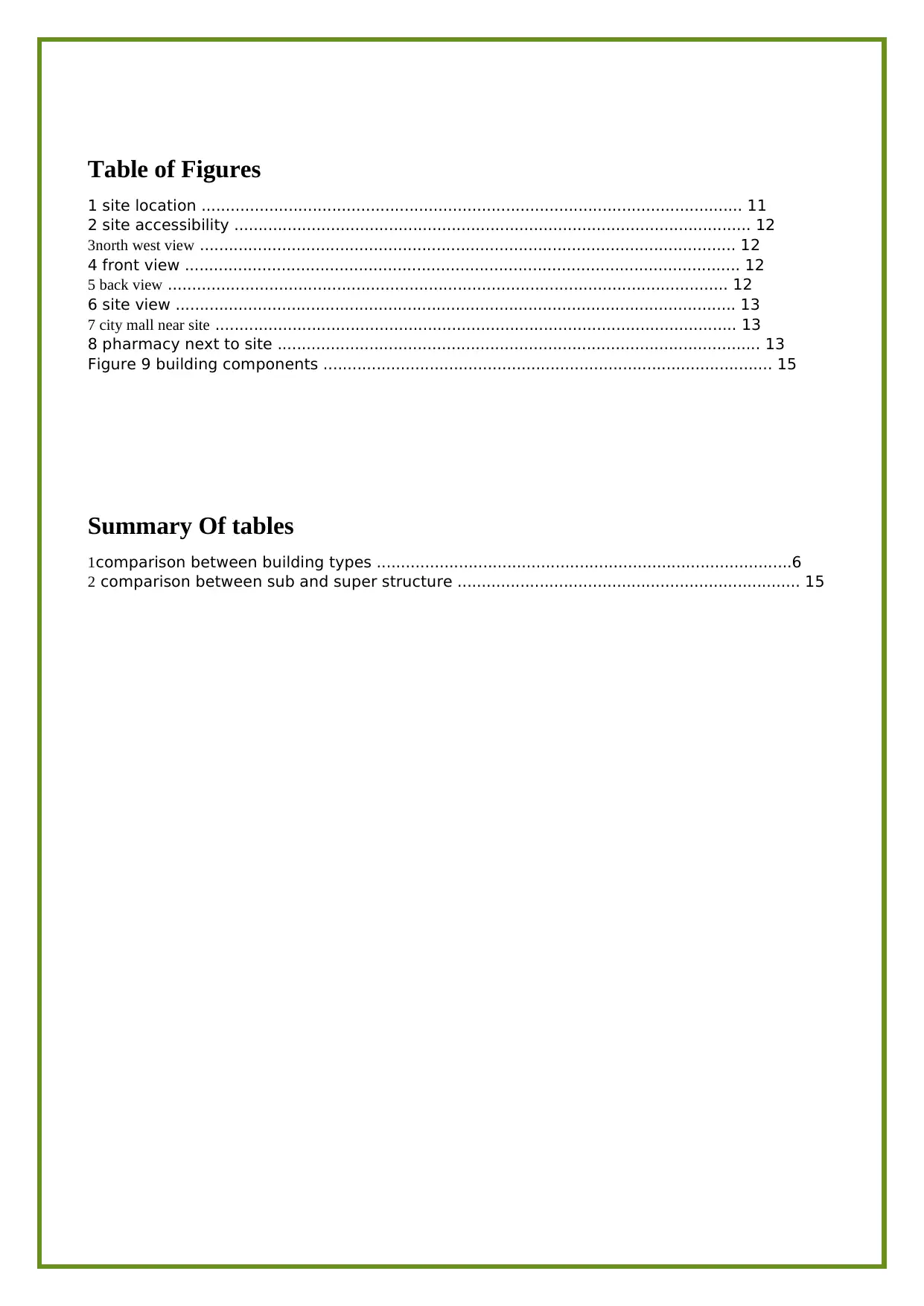
Table of Figures
1 site location ................................................................................................................ 11
2 site accessibility ........................................................................................................... 12
3north west view ............................................................................................................... 12
4 front view ................................................................................................................... 12
5 back view .................................................................................................................... 12
6 site view .................................................................................................................... 13
7 city mall near site ............................................................................................................ 13
8 pharmacy next to site .................................................................................................... 13
Figure 9 building components ............................................................................................. 15
Summary Of tables
1comparison between building types ......................................................................................6
2 comparison between sub and super structure ....................................................................... 15
1 site location ................................................................................................................ 11
2 site accessibility ........................................................................................................... 12
3north west view ............................................................................................................... 12
4 front view ................................................................................................................... 12
5 back view .................................................................................................................... 12
6 site view .................................................................................................................... 13
7 city mall near site ............................................................................................................ 13
8 pharmacy next to site .................................................................................................... 13
Figure 9 building components ............................................................................................. 15
Summary Of tables
1comparison between building types ......................................................................................6
2 comparison between sub and super structure ....................................................................... 15
⊘ This is a preview!⊘
Do you want full access?
Subscribe today to unlock all pages.

Trusted by 1+ million students worldwide
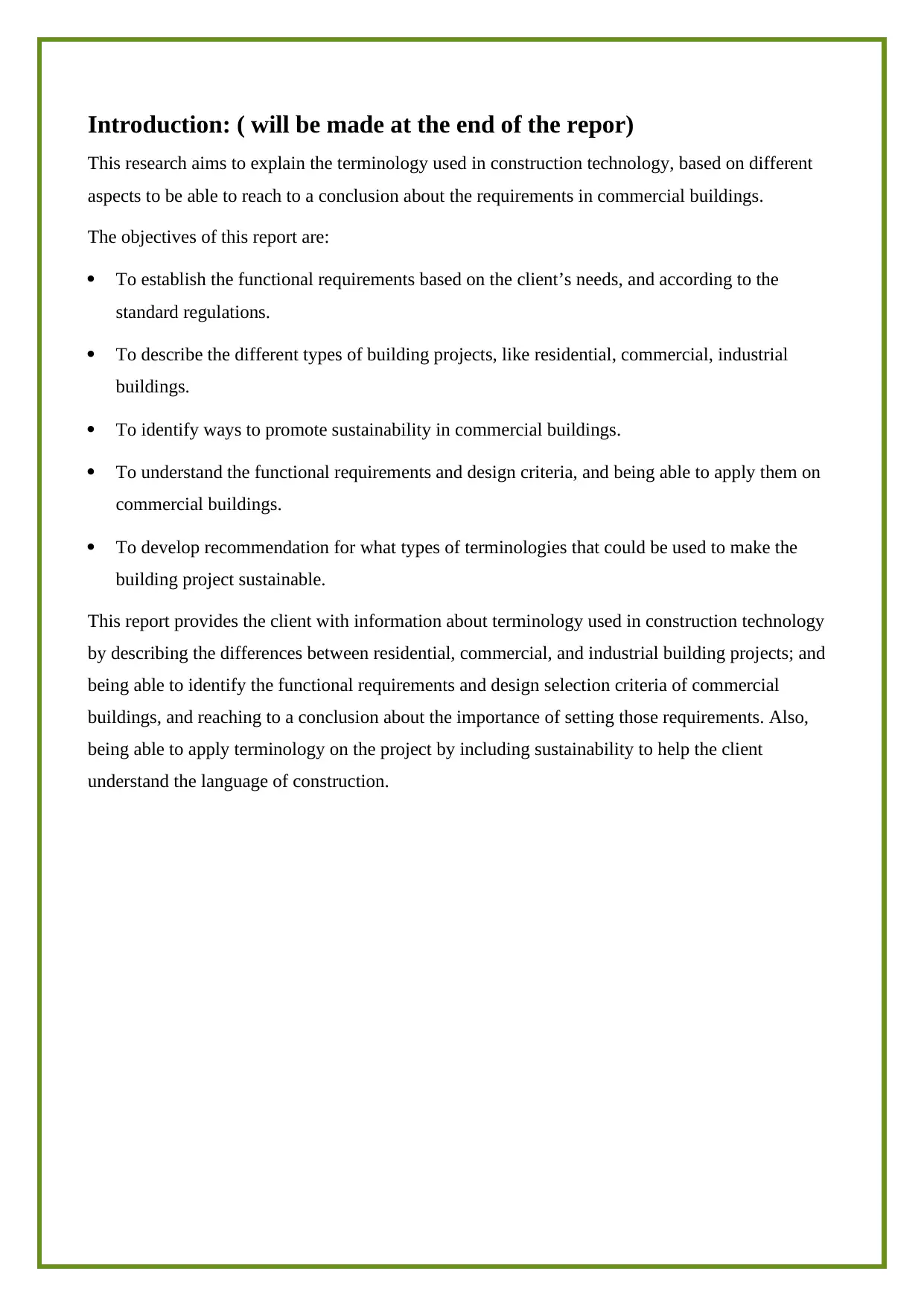
Introduction: ( will be made at the end of the repor)
This research aims to explain the terminology used in construction technology, based on different
aspects to be able to reach to a conclusion about the requirements in commercial buildings.
The objectives of this report are:
To establish the functional requirements based on the client’s needs, and according to the
standard regulations.
To describe the different types of building projects, like residential, commercial, industrial
buildings.
To identify ways to promote sustainability in commercial buildings.
To understand the functional requirements and design criteria, and being able to apply them on
commercial buildings.
To develop recommendation for what types of terminologies that could be used to make the
building project sustainable.
This report provides the client with information about terminology used in construction technology
by describing the differences between residential, commercial, and industrial building projects; and
being able to identify the functional requirements and design selection criteria of commercial
buildings, and reaching to a conclusion about the importance of setting those requirements. Also,
being able to apply terminology on the project by including sustainability to help the client
understand the language of construction.
This research aims to explain the terminology used in construction technology, based on different
aspects to be able to reach to a conclusion about the requirements in commercial buildings.
The objectives of this report are:
To establish the functional requirements based on the client’s needs, and according to the
standard regulations.
To describe the different types of building projects, like residential, commercial, industrial
buildings.
To identify ways to promote sustainability in commercial buildings.
To understand the functional requirements and design criteria, and being able to apply them on
commercial buildings.
To develop recommendation for what types of terminologies that could be used to make the
building project sustainable.
This report provides the client with information about terminology used in construction technology
by describing the differences between residential, commercial, and industrial building projects; and
being able to identify the functional requirements and design selection criteria of commercial
buildings, and reaching to a conclusion about the importance of setting those requirements. Also,
being able to apply terminology on the project by including sustainability to help the client
understand the language of construction.
Paraphrase This Document
Need a fresh take? Get an instant paraphrase of this document with our AI Paraphraser
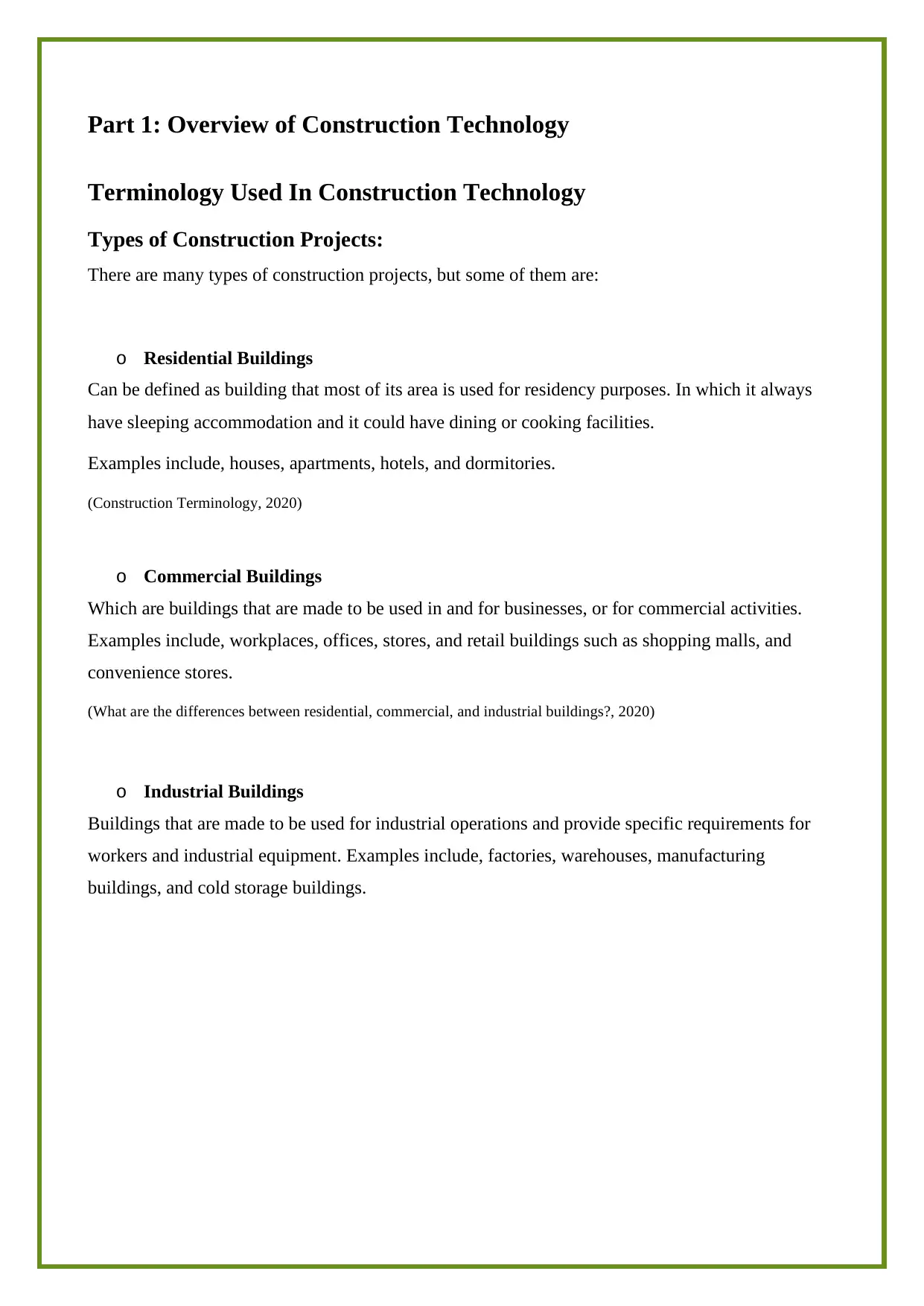
Part 1: Overview of Construction Technology
Terminology Used In Construction Technology
Types of Construction Projects:
There are many types of construction projects, but some of them are:
o Residential Buildings
Can be defined as building that most of its area is used for residency purposes. In which it always
have sleeping accommodation and it could have dining or cooking facilities.
Examples include, houses, apartments, hotels, and dormitories.
(Construction Terminology, 2020)
o Commercial Buildings
Which are buildings that are made to be used in and for businesses, or for commercial activities.
Examples include, workplaces, offices, stores, and retail buildings such as shopping malls, and
convenience stores.
(What are the differences between residential, commercial, and industrial buildings?, 2020)
o Industrial Buildings
Buildings that are made to be used for industrial operations and provide specific requirements for
workers and industrial equipment. Examples include, factories, warehouses, manufacturing
buildings, and cold storage buildings.
Terminology Used In Construction Technology
Types of Construction Projects:
There are many types of construction projects, but some of them are:
o Residential Buildings
Can be defined as building that most of its area is used for residency purposes. In which it always
have sleeping accommodation and it could have dining or cooking facilities.
Examples include, houses, apartments, hotels, and dormitories.
(Construction Terminology, 2020)
o Commercial Buildings
Which are buildings that are made to be used in and for businesses, or for commercial activities.
Examples include, workplaces, offices, stores, and retail buildings such as shopping malls, and
convenience stores.
(What are the differences between residential, commercial, and industrial buildings?, 2020)
o Industrial Buildings
Buildings that are made to be used for industrial operations and provide specific requirements for
workers and industrial equipment. Examples include, factories, warehouses, manufacturing
buildings, and cold storage buildings.
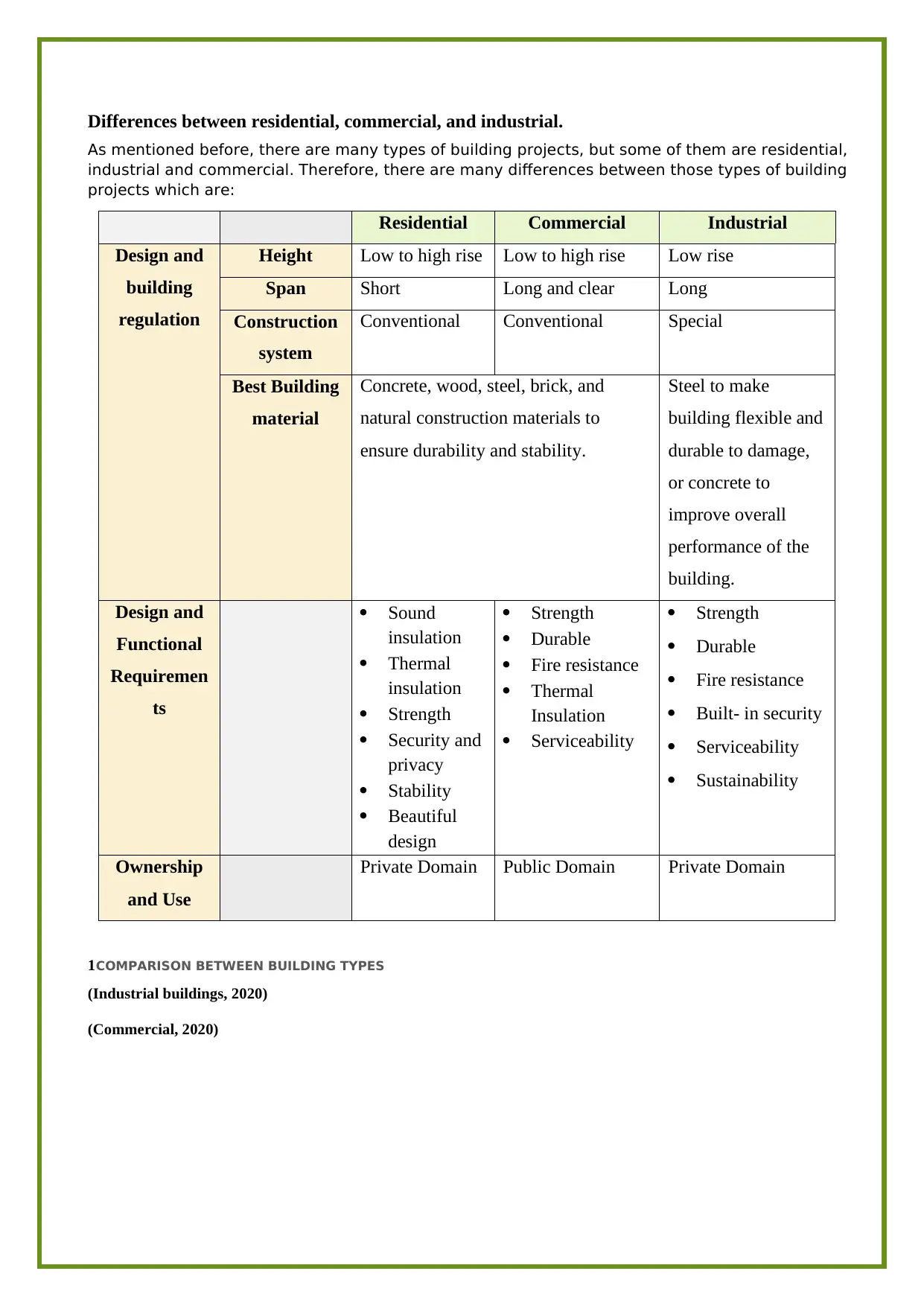
Differences between residential, commercial, and industrial.
As mentioned before, there are many types of building projects, but some of them are residential,
industrial and commercial. Therefore, there are many differences between those types of building
projects which are:
Residential Commercial Industrial
Design and
building
regulation
Height Low to high rise Low to high rise Low rise
Span Short Long and clear Long
Construction
system
Conventional Conventional Special
Best Building
material
Concrete, wood, steel, brick, and
natural construction materials to
ensure durability and stability.
Steel to make
building flexible and
durable to damage,
or concrete to
improve overall
performance of the
building.
Design and
Functional
Requiremen
ts
Sound
insulation
Thermal
insulation
Strength
Security and
privacy
Stability
Beautiful
design
Strength
Durable
Fire resistance
Thermal
Insulation
Serviceability
Strength
Durable
Fire resistance
Built- in security
Serviceability
Sustainability
Ownership
and Use
Private Domain Public Domain Private Domain
1COMPARISON BETWEEN BUILDING TYPES
(Industrial buildings, 2020)
(Commercial, 2020)
As mentioned before, there are many types of building projects, but some of them are residential,
industrial and commercial. Therefore, there are many differences between those types of building
projects which are:
Residential Commercial Industrial
Design and
building
regulation
Height Low to high rise Low to high rise Low rise
Span Short Long and clear Long
Construction
system
Conventional Conventional Special
Best Building
material
Concrete, wood, steel, brick, and
natural construction materials to
ensure durability and stability.
Steel to make
building flexible and
durable to damage,
or concrete to
improve overall
performance of the
building.
Design and
Functional
Requiremen
ts
Sound
insulation
Thermal
insulation
Strength
Security and
privacy
Stability
Beautiful
design
Strength
Durable
Fire resistance
Thermal
Insulation
Serviceability
Strength
Durable
Fire resistance
Built- in security
Serviceability
Sustainability
Ownership
and Use
Private Domain Public Domain Private Domain
1COMPARISON BETWEEN BUILDING TYPES
(Industrial buildings, 2020)
(Commercial, 2020)
⊘ This is a preview!⊘
Do you want full access?
Subscribe today to unlock all pages.

Trusted by 1+ million students worldwide
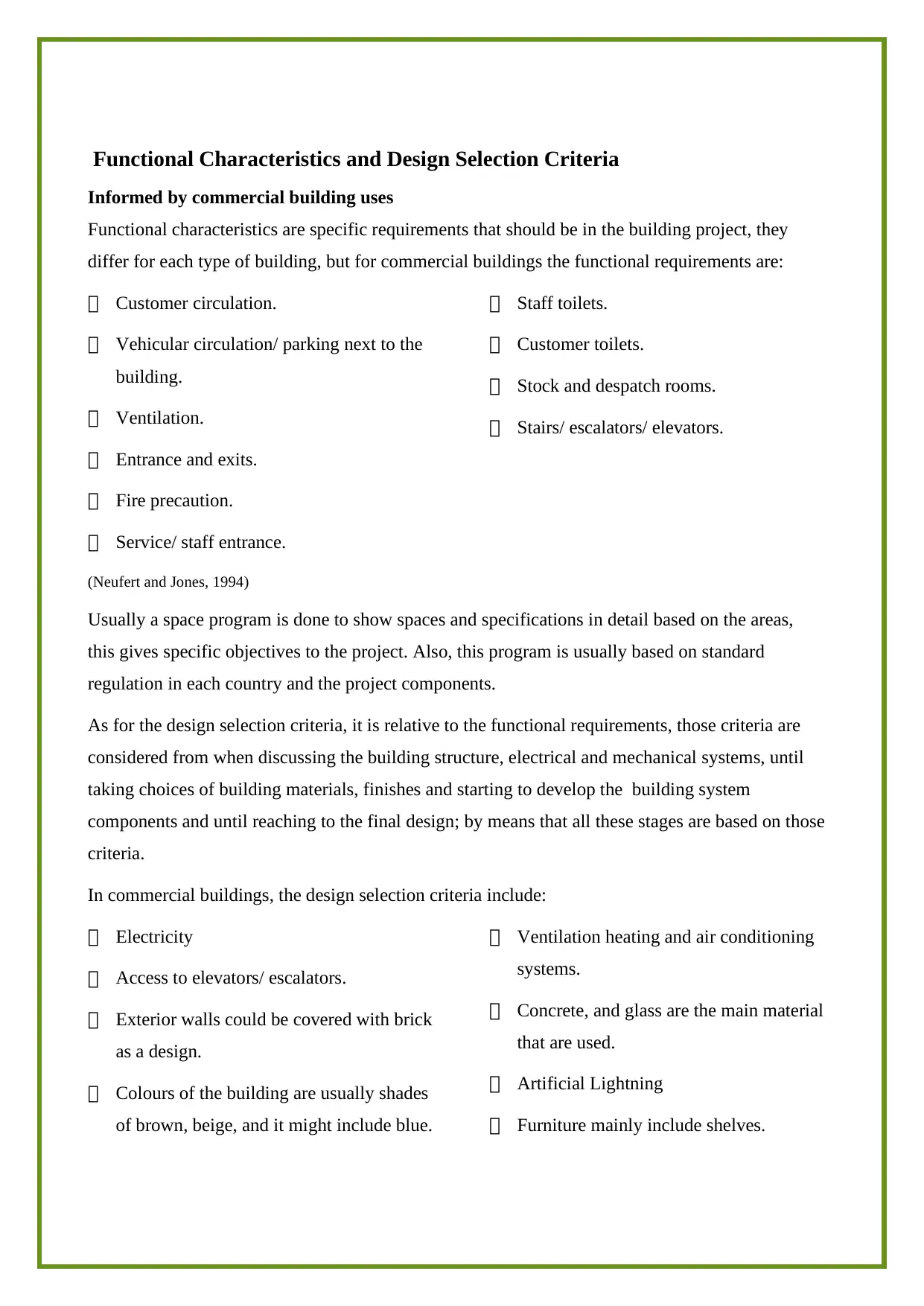
Functional Characteristics and Design Selection Criteria
Informed by commercial building uses
Functional characteristics are specific requirements that should be in the building project, they
differ for each type of building, but for commercial buildings the functional requirements are:
Customer circulation.
Vehicular circulation/ parking next to the
building.
Ventilation.
Entrance and exits.
Fire precaution.
Service/ staff entrance.
Staff toilets.
Customer toilets.
Stock and despatch rooms.
Stairs/ escalators/ elevators.
(Neufert and Jones, 1994)
Usually a space program is done to show spaces and specifications in detail based on the areas,
this gives specific objectives to the project. Also, this program is usually based on standard
regulation in each country and the project components.
As for the design selection criteria, it is relative to the functional requirements, those criteria are
considered from when discussing the building structure, electrical and mechanical systems, until
taking choices of building materials, finishes and starting to develop the building system
components and until reaching to the final design; by means that all these stages are based on those
criteria.
In commercial buildings, the design selection criteria include:
Electricity
Access to elevators/ escalators.
Exterior walls could be covered with brick
as a design.
Colours of the building are usually shades
of brown, beige, and it might include blue.
Ventilation heating and air conditioning
systems.
Concrete, and glass are the main material
that are used.
Artificial Lightning
Furniture mainly include shelves.
Informed by commercial building uses
Functional characteristics are specific requirements that should be in the building project, they
differ for each type of building, but for commercial buildings the functional requirements are:
Customer circulation.
Vehicular circulation/ parking next to the
building.
Ventilation.
Entrance and exits.
Fire precaution.
Service/ staff entrance.
Staff toilets.
Customer toilets.
Stock and despatch rooms.
Stairs/ escalators/ elevators.
(Neufert and Jones, 1994)
Usually a space program is done to show spaces and specifications in detail based on the areas,
this gives specific objectives to the project. Also, this program is usually based on standard
regulation in each country and the project components.
As for the design selection criteria, it is relative to the functional requirements, those criteria are
considered from when discussing the building structure, electrical and mechanical systems, until
taking choices of building materials, finishes and starting to develop the building system
components and until reaching to the final design; by means that all these stages are based on those
criteria.
In commercial buildings, the design selection criteria include:
Electricity
Access to elevators/ escalators.
Exterior walls could be covered with brick
as a design.
Colours of the building are usually shades
of brown, beige, and it might include blue.
Ventilation heating and air conditioning
systems.
Concrete, and glass are the main material
that are used.
Artificial Lightning
Furniture mainly include shelves.
Paraphrase This Document
Need a fresh take? Get an instant paraphrase of this document with our AI Paraphraser
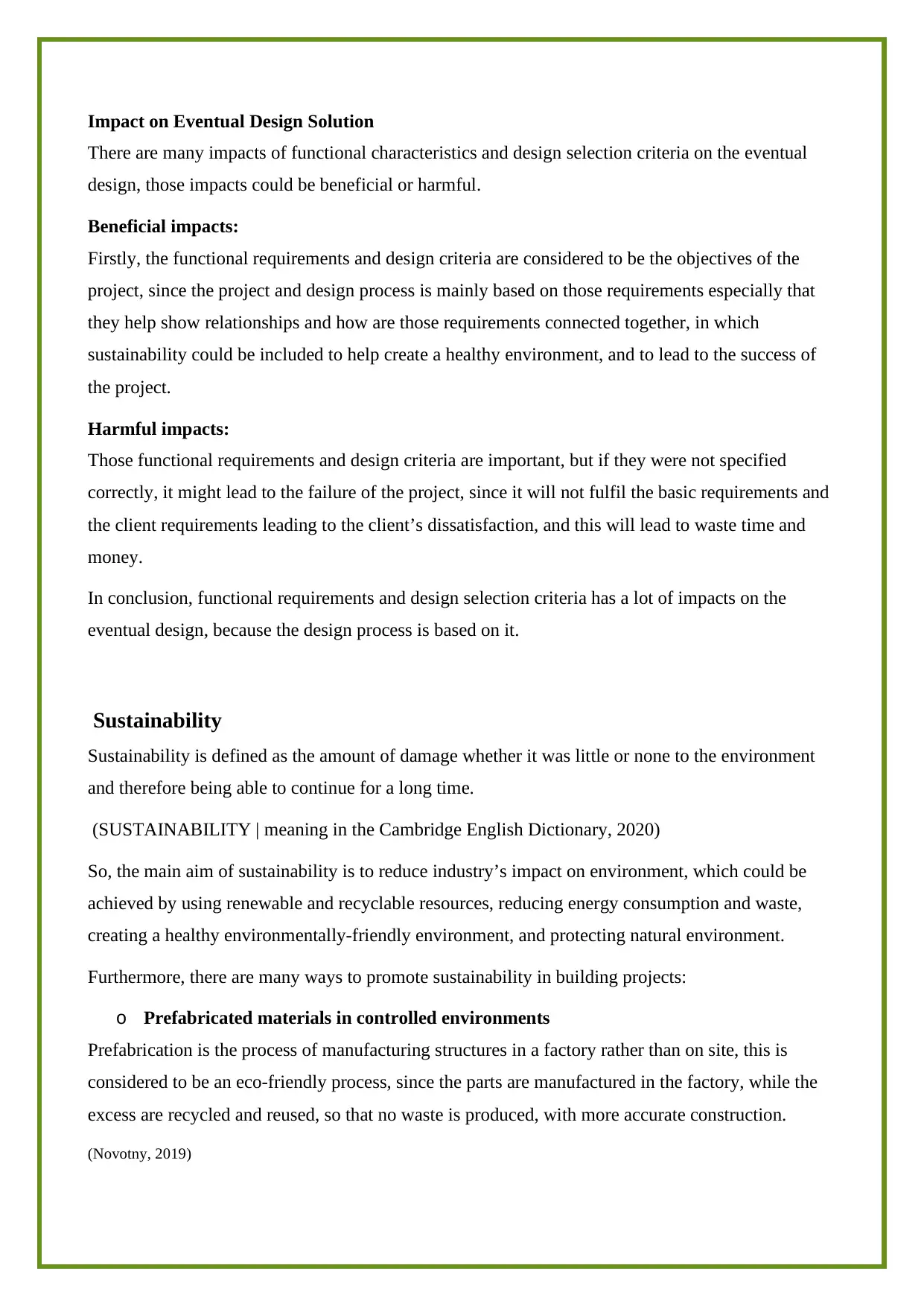
Impact on Eventual Design Solution
There are many impacts of functional characteristics and design selection criteria on the eventual
design, those impacts could be beneficial or harmful.
Beneficial impacts:
Firstly, the functional requirements and design criteria are considered to be the objectives of the
project, since the project and design process is mainly based on those requirements especially that
they help show relationships and how are those requirements connected together, in which
sustainability could be included to help create a healthy environment, and to lead to the success of
the project.
Harmful impacts:
Those functional requirements and design criteria are important, but if they were not specified
correctly, it might lead to the failure of the project, since it will not fulfil the basic requirements and
the client requirements leading to the client’s dissatisfaction, and this will lead to waste time and
money.
In conclusion, functional requirements and design selection criteria has a lot of impacts on the
eventual design, because the design process is based on it.
Sustainability
Sustainability is defined as the amount of damage whether it was little or none to the environment
and therefore being able to continue for a long time.
(SUSTAINABILITY | meaning in the Cambridge English Dictionary, 2020)
So, the main aim of sustainability is to reduce industry’s impact on environment, which could be
achieved by using renewable and recyclable resources, reducing energy consumption and waste,
creating a healthy environmentally-friendly environment, and protecting natural environment.
Furthermore, there are many ways to promote sustainability in building projects:
o Prefabricated materials in controlled environments
Prefabrication is the process of manufacturing structures in a factory rather than on site, this is
considered to be an eco-friendly process, since the parts are manufactured in the factory, while the
excess are recycled and reused, so that no waste is produced, with more accurate construction.
(Novotny, 2019)
There are many impacts of functional characteristics and design selection criteria on the eventual
design, those impacts could be beneficial or harmful.
Beneficial impacts:
Firstly, the functional requirements and design criteria are considered to be the objectives of the
project, since the project and design process is mainly based on those requirements especially that
they help show relationships and how are those requirements connected together, in which
sustainability could be included to help create a healthy environment, and to lead to the success of
the project.
Harmful impacts:
Those functional requirements and design criteria are important, but if they were not specified
correctly, it might lead to the failure of the project, since it will not fulfil the basic requirements and
the client requirements leading to the client’s dissatisfaction, and this will lead to waste time and
money.
In conclusion, functional requirements and design selection criteria has a lot of impacts on the
eventual design, because the design process is based on it.
Sustainability
Sustainability is defined as the amount of damage whether it was little or none to the environment
and therefore being able to continue for a long time.
(SUSTAINABILITY | meaning in the Cambridge English Dictionary, 2020)
So, the main aim of sustainability is to reduce industry’s impact on environment, which could be
achieved by using renewable and recyclable resources, reducing energy consumption and waste,
creating a healthy environmentally-friendly environment, and protecting natural environment.
Furthermore, there are many ways to promote sustainability in building projects:
o Prefabricated materials in controlled environments
Prefabrication is the process of manufacturing structures in a factory rather than on site, this is
considered to be an eco-friendly process, since the parts are manufactured in the factory, while the
excess are recycled and reused, so that no waste is produced, with more accurate construction.
(Novotny, 2019)
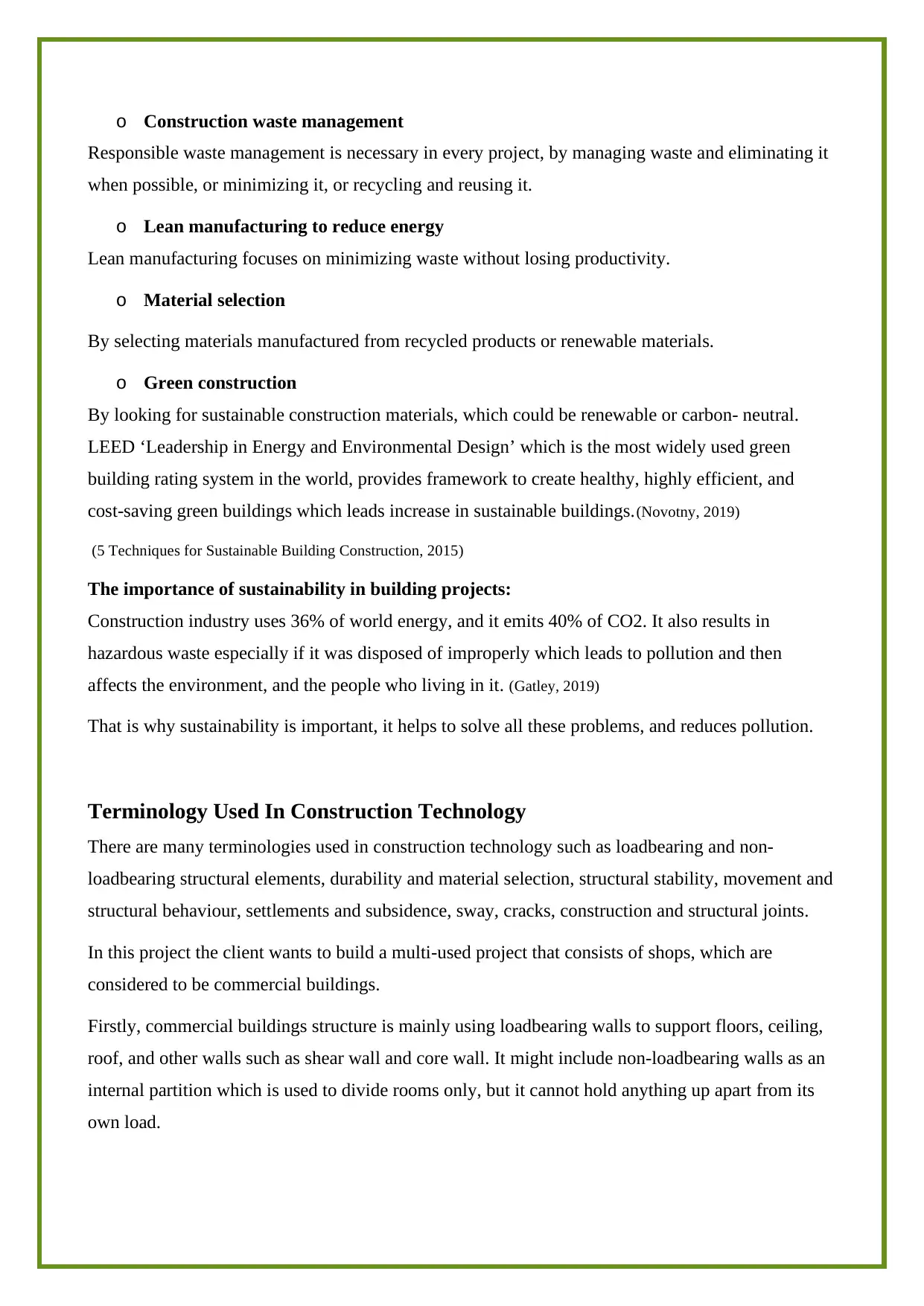
o Construction waste management
Responsible waste management is necessary in every project, by managing waste and eliminating it
when possible, or minimizing it, or recycling and reusing it.
o Lean manufacturing to reduce energy
Lean manufacturing focuses on minimizing waste without losing productivity.
o Material selection
By selecting materials manufactured from recycled products or renewable materials.
o Green construction
By looking for sustainable construction materials, which could be renewable or carbon- neutral.
LEED ‘Leadership in Energy and Environmental Design’ which is the most widely used green
building rating system in the world, provides framework to create healthy, highly efficient, and
cost-saving green buildings which leads increase in sustainable buildings.(Novotny, 2019)
(5 Techniques for Sustainable Building Construction, 2015)
The importance of sustainability in building projects:
Construction industry uses 36% of world energy, and it emits 40% of CO2. It also results in
hazardous waste especially if it was disposed of improperly which leads to pollution and then
affects the environment, and the people who living in it. (Gatley, 2019)
That is why sustainability is important, it helps to solve all these problems, and reduces pollution.
Terminology Used In Construction Technology
There are many terminologies used in construction technology such as loadbearing and non-
loadbearing structural elements, durability and material selection, structural stability, movement and
structural behaviour, settlements and subsidence, sway, cracks, construction and structural joints.
In this project the client wants to build a multi-used project that consists of shops, which are
considered to be commercial buildings.
Firstly, commercial buildings structure is mainly using loadbearing walls to support floors, ceiling,
roof, and other walls such as shear wall and core wall. It might include non-loadbearing walls as an
internal partition which is used to divide rooms only, but it cannot hold anything up apart from its
own load.
Responsible waste management is necessary in every project, by managing waste and eliminating it
when possible, or minimizing it, or recycling and reusing it.
o Lean manufacturing to reduce energy
Lean manufacturing focuses on minimizing waste without losing productivity.
o Material selection
By selecting materials manufactured from recycled products or renewable materials.
o Green construction
By looking for sustainable construction materials, which could be renewable or carbon- neutral.
LEED ‘Leadership in Energy and Environmental Design’ which is the most widely used green
building rating system in the world, provides framework to create healthy, highly efficient, and
cost-saving green buildings which leads increase in sustainable buildings.(Novotny, 2019)
(5 Techniques for Sustainable Building Construction, 2015)
The importance of sustainability in building projects:
Construction industry uses 36% of world energy, and it emits 40% of CO2. It also results in
hazardous waste especially if it was disposed of improperly which leads to pollution and then
affects the environment, and the people who living in it. (Gatley, 2019)
That is why sustainability is important, it helps to solve all these problems, and reduces pollution.
Terminology Used In Construction Technology
There are many terminologies used in construction technology such as loadbearing and non-
loadbearing structural elements, durability and material selection, structural stability, movement and
structural behaviour, settlements and subsidence, sway, cracks, construction and structural joints.
In this project the client wants to build a multi-used project that consists of shops, which are
considered to be commercial buildings.
Firstly, commercial buildings structure is mainly using loadbearing walls to support floors, ceiling,
roof, and other walls such as shear wall and core wall. It might include non-loadbearing walls as an
internal partition which is used to divide rooms only, but it cannot hold anything up apart from its
own load.
⊘ This is a preview!⊘
Do you want full access?
Subscribe today to unlock all pages.

Trusted by 1+ million students worldwide
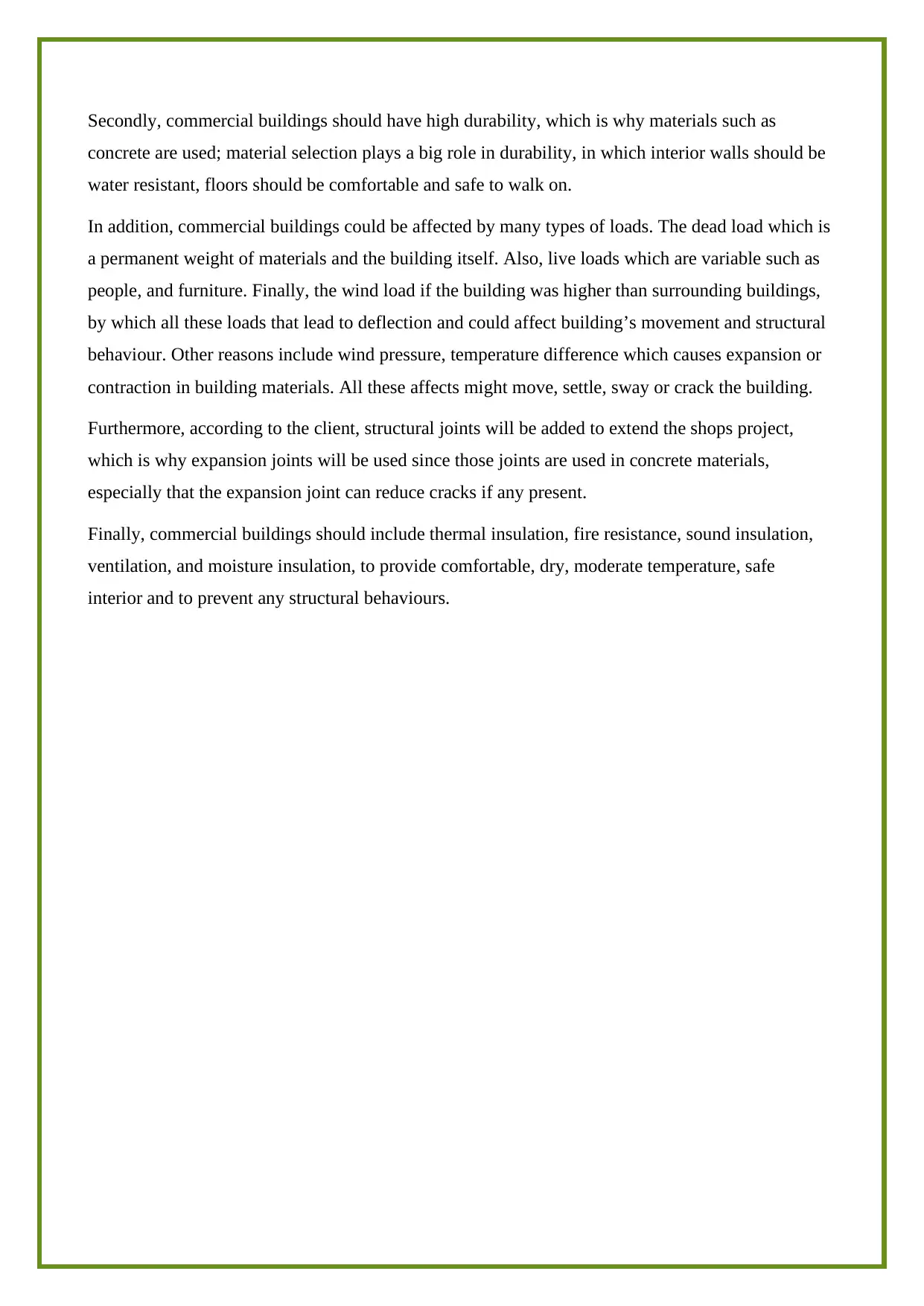
Secondly, commercial buildings should have high durability, which is why materials such as
concrete are used; material selection plays a big role in durability, in which interior walls should be
water resistant, floors should be comfortable and safe to walk on.
In addition, commercial buildings could be affected by many types of loads. The dead load which is
a permanent weight of materials and the building itself. Also, live loads which are variable such as
people, and furniture. Finally, the wind load if the building was higher than surrounding buildings,
by which all these loads that lead to deflection and could affect building’s movement and structural
behaviour. Other reasons include wind pressure, temperature difference which causes expansion or
contraction in building materials. All these affects might move, settle, sway or crack the building.
Furthermore, according to the client, structural joints will be added to extend the shops project,
which is why expansion joints will be used since those joints are used in concrete materials,
especially that the expansion joint can reduce cracks if any present.
Finally, commercial buildings should include thermal insulation, fire resistance, sound insulation,
ventilation, and moisture insulation, to provide comfortable, dry, moderate temperature, safe
interior and to prevent any structural behaviours.
concrete are used; material selection plays a big role in durability, in which interior walls should be
water resistant, floors should be comfortable and safe to walk on.
In addition, commercial buildings could be affected by many types of loads. The dead load which is
a permanent weight of materials and the building itself. Also, live loads which are variable such as
people, and furniture. Finally, the wind load if the building was higher than surrounding buildings,
by which all these loads that lead to deflection and could affect building’s movement and structural
behaviour. Other reasons include wind pressure, temperature difference which causes expansion or
contraction in building materials. All these affects might move, settle, sway or crack the building.
Furthermore, according to the client, structural joints will be added to extend the shops project,
which is why expansion joints will be used since those joints are used in concrete materials,
especially that the expansion joint can reduce cracks if any present.
Finally, commercial buildings should include thermal insulation, fire resistance, sound insulation,
ventilation, and moisture insulation, to provide comfortable, dry, moderate temperature, safe
interior and to prevent any structural behaviours.
Paraphrase This Document
Need a fresh take? Get an instant paraphrase of this document with our AI Paraphraser
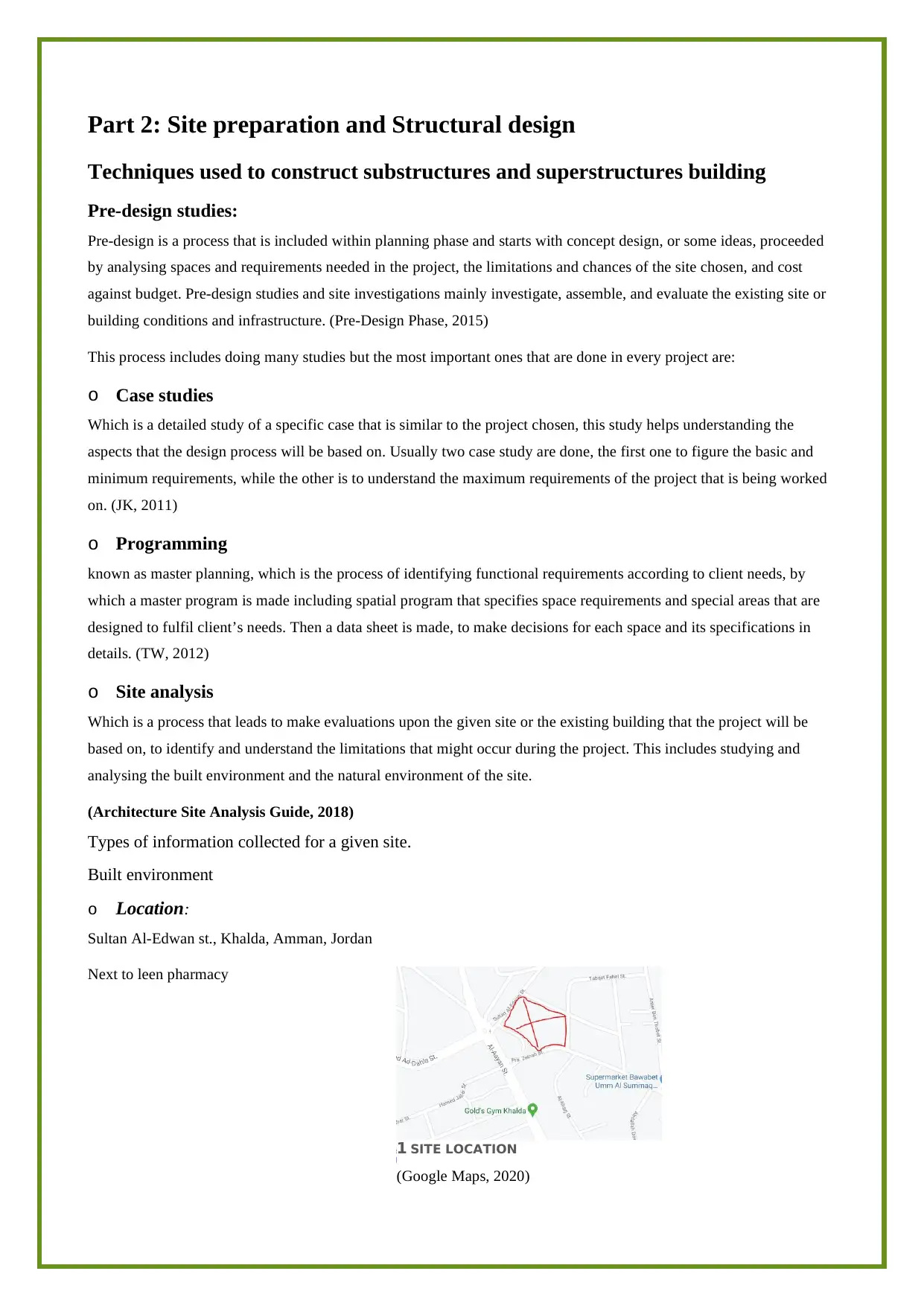
Part 2: Site preparation and Structural design
Techniques used to construct substructures and superstructures building
Pre-design studies:
Pre-design is a process that is included within planning phase and starts with concept design, or some ideas, proceeded
by analysing spaces and requirements needed in the project, the limitations and chances of the site chosen, and cost
against budget. Pre-design studies and site investigations mainly investigate, assemble, and evaluate the existing site or
building conditions and infrastructure. (Pre-Design Phase, 2015)
This process includes doing many studies but the most important ones that are done in every project are:
o Case studies
Which is a detailed study of a specific case that is similar to the project chosen, this study helps understanding the
aspects that the design process will be based on. Usually two case study are done, the first one to figure the basic and
minimum requirements, while the other is to understand the maximum requirements of the project that is being worked
on. (JK, 2011)
o Programming
known as master planning, which is the process of identifying functional requirements according to client needs, by
which a master program is made including spatial program that specifies space requirements and special areas that are
designed to fulfil client’s needs. Then a data sheet is made, to make decisions for each space and its specifications in
details. (TW, 2012)
o Site analysis
Which is a process that leads to make evaluations upon the given site or the existing building that the project will be
based on, to identify and understand the limitations that might occur during the project. This includes studying and
analysing the built environment and the natural environment of the site.
(Architecture Site Analysis Guide, 2018)
Types of information collected for a given site.
Built environment
o Location:
Sultan Al-Edwan st., Khalda, Amman, Jordan
Next to leen pharmacy
1 SITE LOCATION
(Google Maps, 2020)
Techniques used to construct substructures and superstructures building
Pre-design studies:
Pre-design is a process that is included within planning phase and starts with concept design, or some ideas, proceeded
by analysing spaces and requirements needed in the project, the limitations and chances of the site chosen, and cost
against budget. Pre-design studies and site investigations mainly investigate, assemble, and evaluate the existing site or
building conditions and infrastructure. (Pre-Design Phase, 2015)
This process includes doing many studies but the most important ones that are done in every project are:
o Case studies
Which is a detailed study of a specific case that is similar to the project chosen, this study helps understanding the
aspects that the design process will be based on. Usually two case study are done, the first one to figure the basic and
minimum requirements, while the other is to understand the maximum requirements of the project that is being worked
on. (JK, 2011)
o Programming
known as master planning, which is the process of identifying functional requirements according to client needs, by
which a master program is made including spatial program that specifies space requirements and special areas that are
designed to fulfil client’s needs. Then a data sheet is made, to make decisions for each space and its specifications in
details. (TW, 2012)
o Site analysis
Which is a process that leads to make evaluations upon the given site or the existing building that the project will be
based on, to identify and understand the limitations that might occur during the project. This includes studying and
analysing the built environment and the natural environment of the site.
(Architecture Site Analysis Guide, 2018)
Types of information collected for a given site.
Built environment
o Location:
Sultan Al-Edwan st., Khalda, Amman, Jordan
Next to leen pharmacy
1 SITE LOCATION
(Google Maps, 2020)
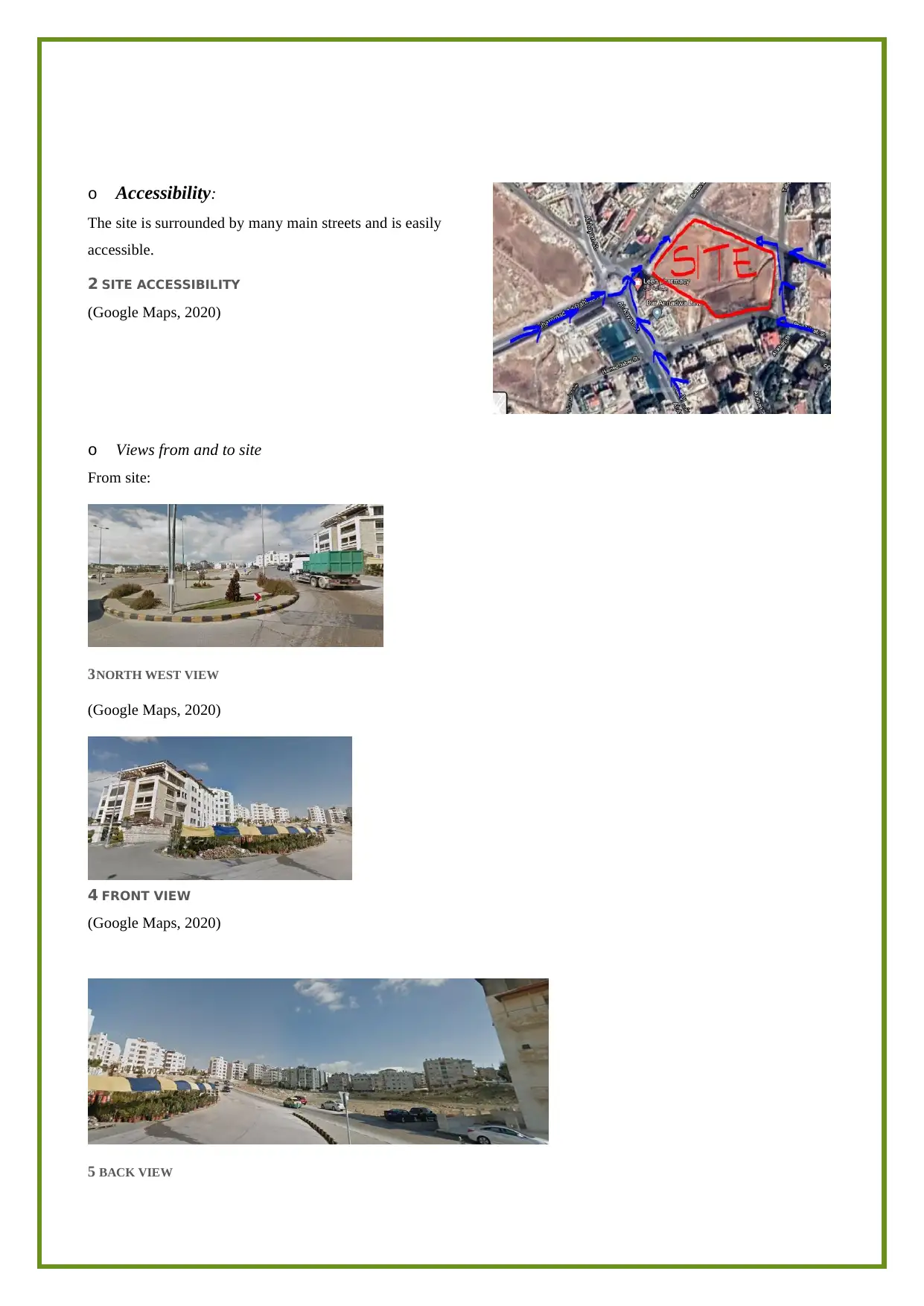
o Accessibility:
The site is surrounded by many main streets and is easily
accessible.
o Views from and to site
From site:
3NORTH WEST VIEW
(Google Maps, 2020)
5 BACK VIEW
4 FRONT VIEW
(Google Maps, 2020)
2 SITE ACCESSIBILITY
(Google Maps, 2020)
The site is surrounded by many main streets and is easily
accessible.
o Views from and to site
From site:
3NORTH WEST VIEW
(Google Maps, 2020)
5 BACK VIEW
4 FRONT VIEW
(Google Maps, 2020)
2 SITE ACCESSIBILITY
(Google Maps, 2020)
⊘ This is a preview!⊘
Do you want full access?
Subscribe today to unlock all pages.

Trusted by 1+ million students worldwide
1 out of 20
Related Documents
Your All-in-One AI-Powered Toolkit for Academic Success.
+13062052269
info@desklib.com
Available 24*7 on WhatsApp / Email
![[object Object]](/_next/static/media/star-bottom.7253800d.svg)
Unlock your academic potential
Copyright © 2020–2025 A2Z Services. All Rights Reserved. Developed and managed by ZUCOL.




